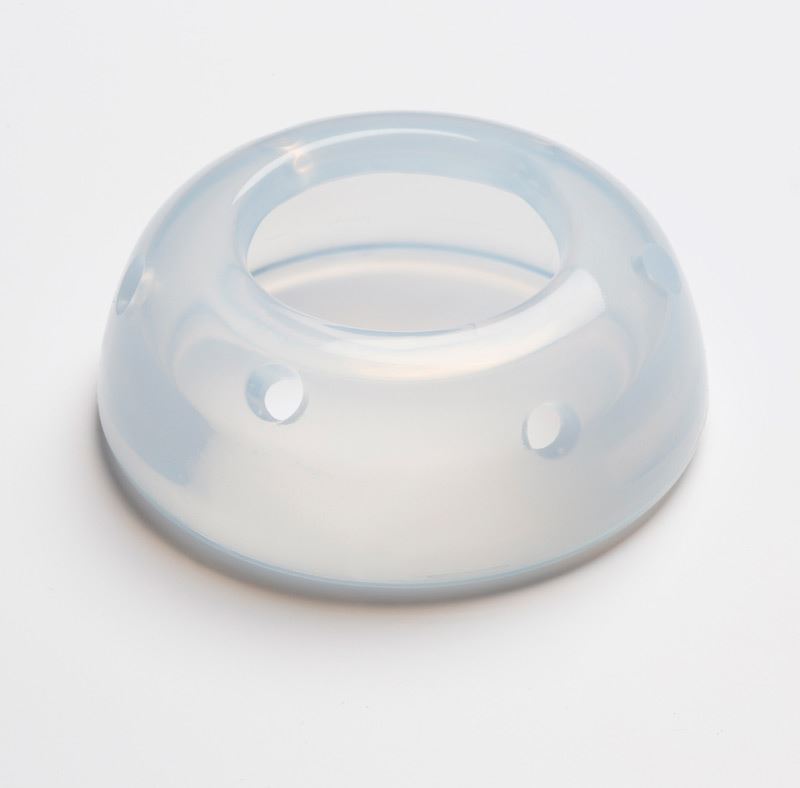Description
The cerclage pessary consists of high-quality silicone. It can be stored at temperatures from 0 to 50 °C protected from UV radiation without contact to reactive media, gas, ozone or mineral oil.
Since the introduction of the device the material and the consistency of the product have been improved. Since 202, objective compression values were adapted according to the to the indication (Model 3).
Application/Intended Purpose
The Cerclage pessary can stay in the virgina more than 30 days (Class IIb). The pessary consists of flexible comfortable silicone. Like all silicone pessaries it is elastic, can be folded and thus be inserted without side effects (pain). The cervical pessary is designed to support the lower uterine segment and the shape of the cervix. The risk of threatining preterm birth is nowadays detected by transviginal sonogrophy. A Cerclage pessary is only indicated in patients with (early or late) changes such as cervical shortening and/or an inner opening of the internal os (funneling). In cases with increased risk by either history (prevoius preterm birth, cervical operations such as cone biopsy) or multiple pregnancy an early transviginal sonography is indicated and should be repeated. If the transvaginal sonogrophy is performed as part of a screening procedure the same cervical changes such as cervical shortening and funneling can occur. The cerclage pessary is indicated for both risk and screening patients.
The treatment can be initiated from 12 gestational weeks onwards (in rare cases with pre-existing short cervix). The pessary is not intended to “close” the cervix but to rotate it towards the sacrum. Hereby, the uterocervical angle between the lower uterine segment and the cervix becomes significantly more acute as compared to the values before placement. In some patients, even funneling and cervival length may restore. In mild forms of genital prolapse (mainly in multiple pregnancy or multi-parous women) the subjective symptoms of pressure may become less after placement.
An increased vaginal discharge is a common side effect, whereby the perforations inside the pessary allow a better drainage. Nevertheless, vaginal discharge should not be confused with a so called “infection” and should not be routinely treated with antibiotics. It could be demonstrated that increased discharge is not associated with a change of the vaginal microbiome. Before insertion, bacterial swabs can be performed to exclude bacterial colonization (no absolute indication). In patients with U-shaped funnelling a wider upper diameter (35 mm) might prevent unnecessary prostaglandin release.
Note
The product is for single use only and must not be used in other patients.
Sizing
Application, monitoring and removal
The instructions are revised according to published studies and post-clinical follow-up.
Before the use of the cerclage pessary please read our most recent version of the instructions Downloads / Instructions.
The essential publications related to the history and practical application a) Arabin and Alfirevic 2013 b) Kyvernitakis et al. 2019
 Text Concept: Text Concept:Laura Goodfellow |
 Voicing: Voicing:Angaharad Care |
The cervical pessary is inserted in a lithotomy position. It is vital that the curvature of the pessary and the smaller diameter show upwards so that the larger diameter is supported by the pelvic floor. The pessary can be folded and then be placed into the vaginal fornix. Thereby the cervix should be located within the upper circumference. After the first application the patient should be re-examined within a week, whereby the position of the device should be checked and it should be documented whether the cervix is still surrounded by the upper circumference. For the duration of the treatment the patient should be treated by the same healthcare provider, preferable in a so called “preterm birth clinic”.
Before removal, the cervix should be carefully pushed back before pulling. If a pessary is “stuck” due to edema or contractions it is better to cut the whole device (e.g. with scissors used for episiotomy) instead of violently pulling and risking cervical lesions. In any case of bleeding or painful contractions a speculum examination should be performed.
Under normal conditions, the pessary should be removed at around 37 weeks in asymptomatic patients. In all patients with premature rupture of membranes and signs of chorioamnionitis, vaginal blood loss or painful contractions the pessary should be removed to avoid cervical lesions or ascending infection.
Transvaginal sonographic examinations help to identify the cervical shape and length but the visualization of transvaginal sonography may be impaired by the pessary and the transducer should to be directed on the anterior or below the posterior part of the pessary lip. The position of the pessary can clinicaly be controlled during routine controls.
In patients with a scheduled Cesarean the pessary can be removed in the operation theatre after anesthesia before the skin incision.
Additional information
| Cerclage-Größen | 65/17/32 mm, 65/17/35 mm, 65/21/32 mm, 65/21/35 mm, 65/25/32 mm, 65/25/35 mm, 65/30/35 mm, 70/17/32 mm, 70/17/35 mm, 70/21/32 mm, 70/21/35 mm, 70/25/32 mm, 70/25/35 mm |
|---|


